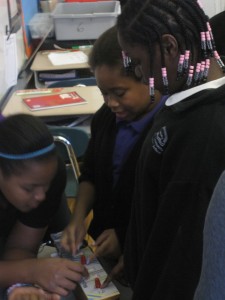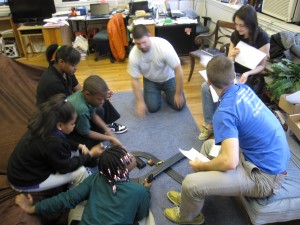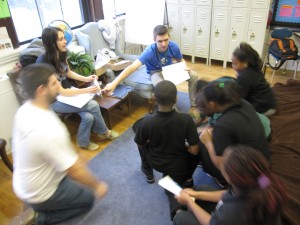Visit #1 to ACCS
Discussion tool: markers and paper to draw
During this visit we were able to get to know the students we’d be working with for the rest of the semester. With each group we asked the kids to draw whatever they like, but to tell about either about what they were drawing, about themselves, or anything else they wanted to talk about. We got to know their interests and some details about their siblings and family. One boy’s comment about liking to produce his own music gave us the idea and inspiration for our response device, which we would bring back to ACCS on our next visit.
Visit #2 to ACCS
Response Device: Sound Board
With this visit to ACCS, we brought our response device with us. This device was a board with an Arduino attached to many different buttons and dials, with a speaker that also worked with the Arduino. When students explored the functions of the buttons, they would manipulate and change the tone coming from the speaker. They were also too many buttons for one student to manage, so we saw really nice results, where the students worked together and collaborated to make interesting sounds. Lots of the students really enjoyed playing with it; there was a constant crowd around the device, with students trying to give their input to the people working the buttons and dials. The boy who had showed interest in producing music during our last visit, however, did not seem very interested in our device, even put off by it. WE thought this was peculiar as everyone else seemed to really enjoy it, yet he showed no interest despite his interest in music production.
Visit #3 to ACCS
Prototype: Slot-car track with controllers and graphs
With this visit we brought the basic concept of what we wanted our final project to consist of. We had a few last minute component failures, like blown transistors, that prevented us from testing our prototype using an Arduino and laptop, but we still tested the same basic exercise by doing it with paper graphs and the slot-car controllers. We showed them a graph, asked them to explain how this graph would translate into physical motion, and then have them show that motion using the slot-cars on the track. While students were jumping to explain the graphs like they were with the sound board, they seemed genuinely curious as to how the graph could relate to the car’s motion. With some students, we had real success in showing them how the graph represented physical movement. For these students, they first were very confused, and frequently made the mistake in thinking that the height of the graph represented the physical height of the car, like a hill. By working out what the height of the graph meant though, we had many students then figure it out completely between them self and the prototype. This was great to see, as they were then able to contribute to the harder graphs that required more of a group discussion among the students. By including these more difficult graphs, we were able to achieve a degree of teamwork and group achievement between the students as well. Overall, despite the shortcomings we had with getting a working prototype on the computer, this prototype served our testing needs fine, and we were able to see that students were able to learn about graphing motion and that they were intrigued by it while also enjoying it overall.
Visit #4 to ACCS
Final Project: 2 Fast, 2 Curious
For the final visit to ACCS, we finally had achieved a fluid, well working game that utilized the slot-car track, an Arduino, and a laptop program to present the interface for interacting with the slot-car. Upon showing the students the final iteration, they seemed slightly less excited about this time, probably because it was very close to what we had shown during our last visit. This time we had them work through the computer game, using the same style of discussion as we did previously. One group had several students who breezed through the first two, but had minor trouble with the last graph. Other groups however were equally challenged on all three graphs, moving towards group work and collaboration on the last graph (the most difficult) like we saw last visit. The students seemed to really enjoy engaging the program, but looked disheartened when the slot-car only performed the graph motions at the end. For further iterations, adding more intervals of movement and allowing more control for the students. We also found that not having the zero line marked often confused the students, as they thought that was “normal speed”. By adding “0” to the graph, marking it, it would then prevent them from making that mistake. Overall though, the students seemed to enjoy it more than our previous prototype version, and they continue to solve the graph problems and work through it nicely, making small discoveries for themselves. The student interacting with the computer though made it less of an teamwork effort, which is a major drawback. A possible reconfiguration to solve this would be to have to students or two groups try and work through it together as a race to get there car moving first. Overall, we think the students really enjoyed the challenge and game 2 Fast, 2 Furious posed for them, but the project certainly has room for expansion and refinement. If you’re reading this and trying our project for yourself, let us know how it goes in the comment box below! We’d love to hear how you improved or changed up our work to better suit your needs.


